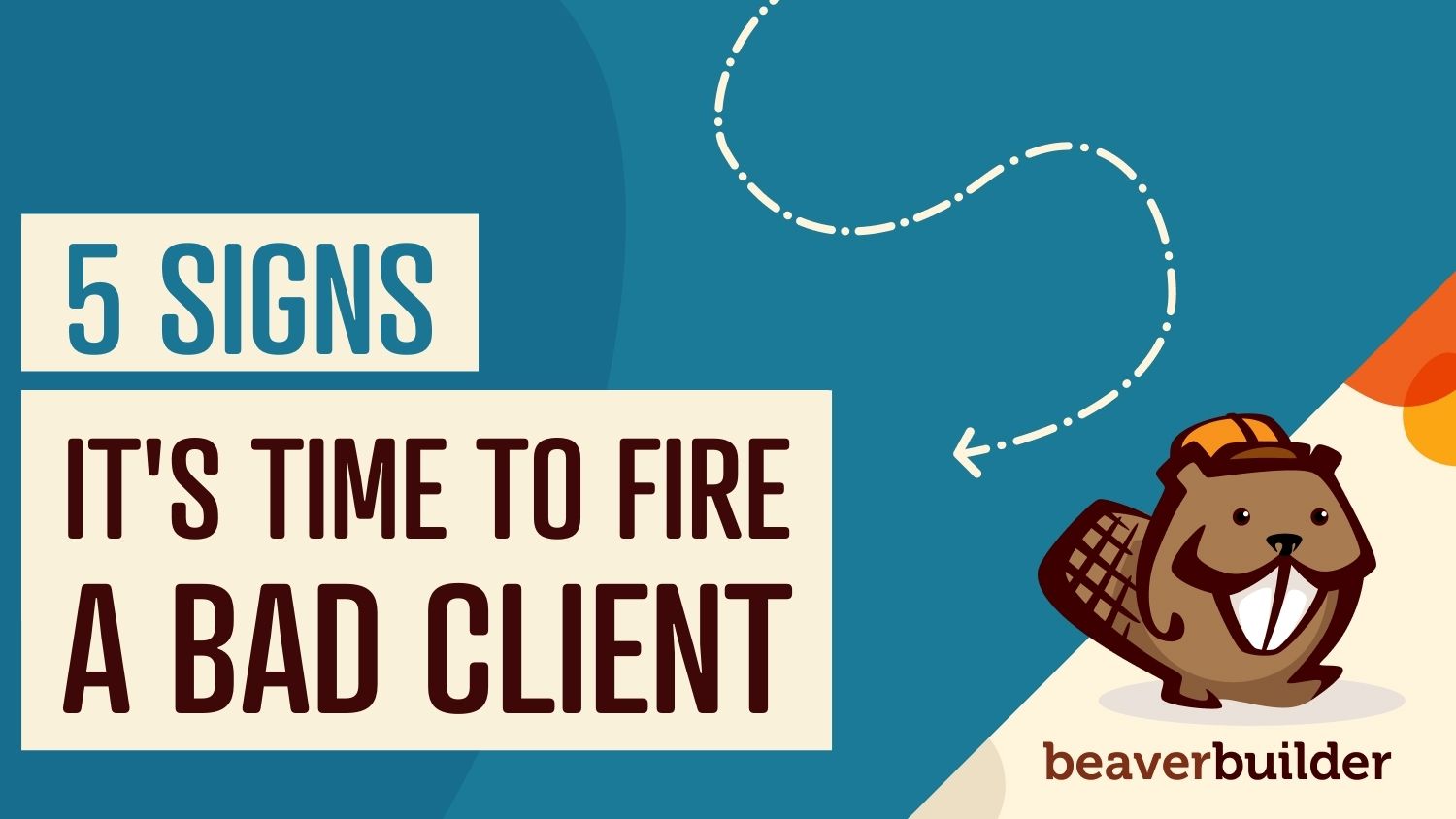
5 Signs It’s Time to Fire a Bad Client (And How to Do It)
Clients come in all shapes and sizes. Unfortunately, you may have some that make you dread every step of your project. You can probably recognize a bad partnership, but knowing when it’s time to end the relationship isn’t always easy.
Fortunately, there are telltale warnings of a doomed professional relationship. In this article, we’ll go over five common signs that it’s time to fire a bad client. Then we’ll walk you through a simple three-step process for doing so. Let’s dive right in!
Why Firing Bad Clients Is Critical
Let’s be honest: it’s not easy parting with a paying client. Part of running your own agency is considering the financial future. This is even more crucial if you’re freelancing on your own.
Given these pressures, it’s not unusual to feel like you need to grin and bear bad clients. However, it doesn’t need to be that way.
Firing ill-fitting clients isn’t a professional faux-pas. On the contrary, it’s an essential skill for any web professional. Learning how to gracefully part ways can be key to your organization’s success.
One reason for this is basic time management. Web projects can be extensive undertakings. If you spend hours crafting the perfect project for a client who can’t pay or returns endless edits, your time is losing value.
It’s not just about the money, either. Constructive criticism is a necessary part of any job. However, when that starts to turn into verbal abuse, team morale is likely to dip. It can be hard to produce quality work when it always ends in a roadblock.
Furthermore, a current bad client can affect your future choices. If you spend enough time in an unhealthy working relationship, you could lose the ability to set professional boundaries. It can lead to you taking on more clients who don’t meet your expectations.
Perhaps most importantly, you deserve fair treatment! Clients pay you for your work, not for putting up with their unreasonable demands. Thus, feeling confident in ending bad partnerships is critical for both your business and your mental health.
5 Signs It’s Time to Fire a Bad Client
If you’re not sure about firing a client, consider how often they display any of the following signs of a doomed professional relationship.
1. Payment Is Late, Inconsistent, or Missing
Let’s start with a big one: payment. We probably don’t have to tell you that money matters. If you’re not earning your rightful pay for a hard day’s work, you could run into financial problems.
Firing a non-paying client probably seems obvious. After all, it’s pretty unlikely that you’d keep working with a person who refuses to compensate you at all.
However, it’s not always that simple. The tricky part comes when the paychecks aren’t missing but are inconsistent.
For example, let’s say a client is very behind on completing your invoices. They always pay you in the end but the payments are never on time. This lack of reliable income can be extremely stressful. Nevertheless, you might not be willing to part with an (eventually) guaranteed paycheck.
One resolution is to pause the partnership instead of ending it. You could explain to your client that you’re happy to restart your work as soon as they resolve all of their outstanding payments. Using overdue balance fees can also be effective.
If you use this strategy, be sure to keep your professional invoices simple and organized. That way, you can clearly demonstrate what each client owes you. Microsoft Office, for example, has a wide variety of helpful templates:

Nevertheless, you might prefer to do away with financial uncertainty altogether. If a client pays you inconsistently and you’d rather not constantly hound them for your fair share, it might be time to say goodbye.
2. Expectations and Compensation Don’t Match Up
As a web professional, you’re probably intimately familiar with the value of your work. This applies to both the price tag on your tools and the cost of your time.
However, not all clients understand these costs. Someone may have sky-high expectations of a gorgeous web page but not the means to pay for it.
This situation can happen because the client doesn’t fully understand web design or development. As such, the associated charges may also be a mystery. If it’s not their area of expertise, they may just be experiencing sticker shock.
If you think this is the case, we’d recommend waiting to fire them. These types of clients may be more receptive to your prices if you can explain them. Consider carving out time for this task during client onboarding.
This is also a convincing reason to establish a solid pricing structure for your services. That way, you can set a policy for your payment expectations.
However, sometimes a partner is not convinced by these measures. You might even run into those who claim that other professionals would do the same job for much less pay. The Twitter parody account A Bad Client pokes fun at this concept:

Try not to get sucked into the competition. If a client is constantly haggling for unreasonably lower prices, you may be better off letting them go.
3. There Are No Successful Compromises
With any client, there’s bound to be some back-and-forth with web design projects. This can be a healthy system of feedback for all involved.
However, striking a balance between your professional opinion and the client’s thoughts can admittedly be tricky. It’s normal to run into a few workplace disagreements from time to time. The real problems arise when compromises become more common than agreements.
A constant inability to compromise can put the whole project in jeopardy. The entire process could stall, remaining unfinished and leaving everyone in limbo. If you don’t want to abandon a project halfway through, keep an eye out for this sign right from the start.
On the other hand, you may be able to push through and finish the work with begrudging compromises on both sides. However, this situation isn’t likely to produce a result anyone is happy with. As such, it can be a huge waste of time for all involved.
Nevertheless, sometimes a lack of compromise is no one’s fault. You can have professional differences with even the most friendly, cooperative clients. However hard it may be, firing them can be the best decision for all of you in this situation.
If you’re trying to avoid these issues altogether, consider brushing up on your client communication skills. Prompt, clear messages can go a long way toward preventing creative mismatches before they become problems.
4. Constructive Criticism Is Replaced With Verbal Harassment
You’re probably used to constructive criticism of your projects. Clients may reasonably disapprove of some of your work. If they can respectfully communicate their concerns, it usually doesn’t pose an issue.
Unfortunately, not all customers understand this concept. Their emotions may get the better of them, leading to full-scale insults. This can be especially true if they’re emotionally invested in the project. Some examples of potential verbal abuse include:
- Attacks on your character
- Valid criticism that’s communicated through insults
- A disproportionately large reaction to a small mistake
Nobody likes to be harassed. However, the experience can be particularly confronting in a professional relationship. When you rely on someone for a paycheck, it can be hard to stick up for yourself.
Nevertheless, remember that it’s essential to defend yourself. While it might not be easy, you need to be your own advocate. Try to address any issues of ill-treatment as soon as they pop up to help prevent escalation.
You can start by stating that you understand the client is upset. Then, follow this up by firmly telling them that such treatment is flatly unacceptable.
If this doesn’t change their behavior, feel free to fire that customer. There’s no shame in walking away from a toxic work environment and finding other high-paying clients.
5. The Client Doesn’t Know What They Want
When we say that a client “doesn’t know what they want”, we’re not necessarily talking about someone who has questions. It’s normal for a customer to be curious about how a project will develop. In fact, a degree of flexibility might make them easier to work with.
However, a lack of clarity can be an issue if it applies to everything. A client who has no clear goal for their website can be a real headache – it’s nearly impossible to provide the right result to someone who doesn’t know what that looks like.
This, in turn, can lead to a wide variety of complications. If a client only figures out what they wanted after the final product is done, you could be forced to redo the same work.
Unsure clients might also request several pieces of spec work. Spec work is any creative effort sent to a client before payment is guaranteed.
While some creative opportunities are legitimate, you risk guiding a client for free. There may also be ownership issues with any work produced. For more information on these potential pitfalls, check out the NO!SPEC website:

To avoid an uncertain client, try to establish concrete goals together early on. If they can’t vocalize what they need from you and aren’t responsive to your advice, ending your working relationship is reasonable. As a bonus, it can also help streamline your development projects.
How to Fire a Bad Client (In 3 Steps)
If any of the above signs hit close to home, it might be time to fire that bad client. Here are three steps to help guide you through the process.
Step 1: Fulfill Any Remaining Contractual Obligations
Before you fire a client, ensure that any contractual obligations have been fully met. Try to double-check that you haven’t forgotten even the smallest promise.
This step serves a few purposes. Perhaps the most obvious is that it prevents any legal repercussions from breaking your agreement.
However, it also makes sure you’ll get the agreed-upon payment for your work. Moreover, your reputation as a freelancer is valuable – holding up your end of the contract even under stress demonstrates your reliability to future clients.
To complete this step successfully, you’ll have to be on top of your document organization. One powerful tool for generating, customizing, and storing client contracts is Bonsai:

Bonsai will help you stay on the same page as your clients every step of the way. If you neatly lay out all expectations from the beginning, it’ll be easier to ensure that you meet all contractual requirements.
While you’re finishing your projects, try to avoid taking on any extra assignments from the client – no matter how small or well-paying. If you’re having a hard time resisting, try to remember the reason you’re firing the customer in the first place.
If any issues prevent you from meeting a contractual obligation, reach out to the client as soon as possible. Situations with legal parameters can be tough to navigate, making open communication critical.
Step 2: Make Direct and Professional Contact
Now comes the hard part: firing your client. You probably don’t need us to tell you that this situation can be uncomfortable for everyone involved. As such, it’s important to keep your message direct and professional.
Firm and decisive communication prevents misunderstandings. If you’re ready to fire a client, you probably have gone past the point of resolution. Being direct can make this message clear to your customer and avoid dragging the situation out.
However, it’s equally important to be as professional as possible. It may be difficult if you’re firing a verbally abusive client. Still, it’s no less essential: staying calm can prevent any further escalation or bad feelings.
As for the format, an email may be the best choice. The fact that it’s written can help you address multiple issues. You can also edit the content before you send it.
If you’re struggling with the exact wording, consider keeping it simple. Feel free to limit the message to a few explanatory sentences and confirm that you’ll address any outstanding work.
Finally, be prepared for a few follow-up questions. Clients may want to understand the process for the future. Respectfully addressing them to the best of your ability can ease the transition for both of you.
Step 3: Set New Boundaries to Avoid Similar Future Situations
Some bad clients are simply impossible to work with. There are no effective strategies to deal with them, and all you can do is fire them and move on.
However, this is far from a universal truth. Sometimes, placing a few boundaries early on in the partnership can prevent roadblocks. Use your outcomes with clients to reassess your client-facing policies before starting a search for more business.
For example, let’s say you just fired a client who didn’t pay you on time. If you want to avoid another mountain of unread invoices, consider refusing to take on new projects until the previous one is fully compensated.
If there was confusion after the firing process, that could also be a learning experience. Consider writing your next contract with specific instructions on what the client can expect when and if the relationship ends. With a clear reference to point to, you can cut down on miscommunication.
Finally, try not to get discouraged. Almost every web professional needs to fire a client from time to time. It doesn’t mean that all clients are challenging – it simply shows that you understand the value of building positive working relationships.
Conclusion
When it comes to customers, the difference between “challenging” and “impossible” can be hard to spot. The decision is ultimately subjective. Fortunately, there are a few hallmarks of bad clients that you can keep in mind to guide your choices.
In this article, we covered five of the most prominent signs that it’s time to fire a bad client:
- Inconsistent or missing compensation
- Unrealistic expectations given their budget
- An inability to reach a successful compromise
- Verbal harassment instead of constructive criticism
- A lack of any clear project goals
Do you have any questions about firing a bad client? Let us know in the comments section below!
3 Comments
Related articles
Best Practices for Managing Web Design Clients
Managing web design clients effectively is one of the most crucial skills for a web designer, agency, or freelancer. Whether…
Top 10 Web Design Trends (What Makes a Great Website?)
As a web designer, you want every website you create to be a great one. This is easier said than…
9 Best CRM Software for Marketing Agencies
Two important objectives for marketing agencies are to improve customer experience and boost sales. To help reach their goals and…
Join the community
We're here for you
There's a thriving community of builders and we'd love for you to join us. Come by and show off a project, network, or ask a question.
Since 2014
Build Your Website in Minutes, Not Months
Join Over 1 Million+ Websites Powered By Beaver Builder.
 Beaver Builder
Beaver Builder 




Practical advice and true. The biggest problem other than payment issues is the “no-spec” they are time consuming and frustrating.
In 23 years of website client work and about 125 clients, I’ve fired about six or seven, always for very early/low level instances of the five things on this list. I basically have zero tolerance for any client who causes me significant anxiety and stress. I’ve always done the firing professionally and made sure they had everything they needed from me.
Some of them have been amazingly hapless and incompetent about it. Recently I gave one guy, a high-priced surgeon, 3 months’ notice, so he’d have plenty of time to find another website person. Contacted him again with reminders at 2 months out, at 1 month out, and at 2 weeks out, and each time he acknowledged the reminders, saying basically “AOK”. At 1 week out, I got a vague, childishly-written email asking if I could “just keep a very *small* website up, since we haven’t had time to hire a new person”, which of course I declined to do. As long as I’ve been fair, courteous and professional, I come out of these encounters feeling OK, but it’s never easy.
One of my biggest mistakes with my last client was, that because I didn’t take enough care of my earnings, I couldn’t fire him when I’ve seen these signs the first time…
When you start working on a project for someone that you’re also really passionate about, and the client either doesn’t know what he wants, either wants things that I know I don’t work, or the worse that he kept forgeting everything I explained him… I had to stay with my mouth shut for 3 months while I was getting sick of the thought that he can call me at any time. Good lesson it was!